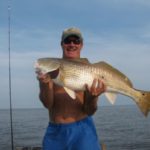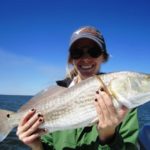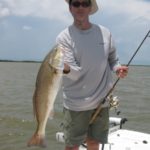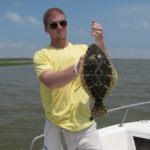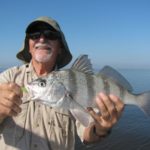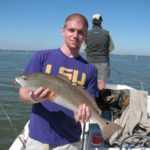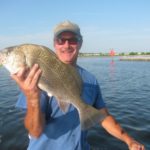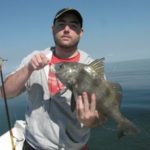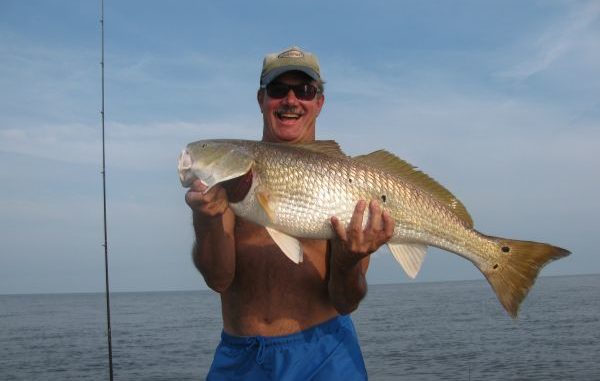
Redfish prowl the entire Louisiana coastline, the waters of Bayou Lamoque and Cox Bay near Empire provide almost virgin territory.
Eddie popped his cork, pointed toward the shoreline with his rod, and blurted, “Looks like that otter’s interested in my cork! Food must be scarce for him around here!”
We all looked over, but Pelayo was first to comment.
“That ain’t no otter, man!” he laughed. “That’s a gator. Better get your bait outta there — and fast!”
Eddie squinted, shielded his eyes and cocked his head forward, pouting his lips.
“Geezum!” he yelled after a few seconds. “You’re right!”
Then he started reeling furiously. The cork was halfway back to the boat when — WHAM!
The water exploded.
“Awww man!” Artie grumbled from the bow. “Now we got ….”
Then the water exploded again — but in a copper swirl.
“Naw-Man — Dat ain’t the gator!” Pelayo whooped. Another copper swirl, and now it became obvious to everyone. “It’s another red. But a grillin one this time!”
“Yeah-You-Rite!” Eddie yelled as his Mitchell 300 started blaring its sweet retro music and he raised his rod high overhead, cocking his head and moving his ear close to the reel for full effect. “Gotta love that sweet music it!”
It so happened we had Baton Rouge’s radio station The Eagle blaring from the boat’s boom box, and it so happened “Hey Jude” was on. We’d all been singing and swaying to the: ” Na…Na…Na..NA-NA-NA” like we were watching it on the Ed Sullivan show, (the night after we’d watch Morgus The Magnificent.)
But for yanking us back to our glorious adolescence, no classic hit from any classic rock station could top the glorious tune blaring from Eddie’s Mitchell 300.
Constant tinkering by Eddie over the years had kept the classic reel performing in top condition. Eddie had even managed to crank up the drag’s volume, and now the results put a smile on everyone’s face. Naturally the widest and craziest was on Eddie’s.
“Hear that?! Hear THAT?!” Eddie yelled as he pointed the reel toward us and cocked his ear. “Man, I can almost hear ‘Jumping Jack Flash’ in the background!”
Eddie’s rod tip knocked Artie’s sunglasses glasses off and almost poked his eye out in all the excitement.
Eddie’s dad (“Mr. Henry”) had bought that reel for him at Security on Carrollton when Bill Kilmer and Gary Cuozzo competed for starting QB rights at Tulane Stadium on Sunday afternoons. Vicious arguments (every bit as heated as the pro- and anti-Les Miles versions of today) raged between fans of Bill “Furnace Face” Kilmer and those of Gary Cuozzo.
The former was not exactly a study in svelte physique and elegant passing technique: His “ruptured duck” passes were classics.
The latter was more refined; his passes — most agreed — were “prettier.”
During commercial breaks while watching Morgus the Magnificent the night before our Sunday afternoon pilgrimages to Tulane Stadium — with “Buy your Chevrolet from Persia-Mike Persia Chevrolet” or “Rosenbergs, Rosenbergs EIGHTEEN TWENTY-FIVE Tulane” — with these commercials our usual backdrop, our adolescent arguments over the relative merits of Kilmer vs Cuozzo often got heated.
But we all agreed that ol’ Danny Abramawics would latch on to anyone that came anywhere near him.
After a heroic struggle (by the fish), Pelayo finally netted Eddie’s Red — about a 6-pounder.
“Don’t remember too many alligators around here back before my northern exile,” Eddie said while stripping off some strands of grass that came in entangled with his cork. “Don’t remember any of this hydrilla grass around here, either.”
“That ain’t hydrilla!” Artie corrected. “It’s Eurasian watermilfoil, if you must know. It’s the grass that grows most abundantly in our coastal marshes that get flushed with Mississippi River waaaw-da. You’ll note in the winter the ducks love to strip the stems bare.
“Everybody around here call it hydrilla — but it ain’t hydrilla — got it?”
“Well, well,” laughed Pelayo. “It’s always nice to have a newly minted botanist and biologist on board!”
We were casting our shrimp-sweetened beetles and shad-rigs to a current-washed grassy point that jutted out into Bay Auguste just northwest of Bayou Lamoque. Amazingly this very point was only slightly eroded from when we fished it in decades past.
The current — carrying “fairly” clear water as such is measured in this area, and as traditionally the case on a falling tide — washed around this point, creating the very conditions we crave.
In early June, you see, the river’s usually high, and the winds usually roaring from the southeast. This means this area can get a double-whammy of muddy river water.
Hence, our tactic is to fish it exclusively on falling tides that bring the clearer water from the interior ponds into the more-open bays, passes and lagoons. This greatly simplifies the fishing for us.
On clear water conditions, you see, the fish are often scattered. They can be anywhere. Under the conditions of early summer, however, we concentrate on finding the clearer water — and generally speaking — we usually find concentrations of fish.
Anyway, at first we’d all cast our shrimp-tipped beetles right at the point, letting our corks go with the flow. In this manner we’d caught two rat reds and two throwbacks, along with two ladyfish and two hardheads.
Then Eddie “muffed” a cast from his line twisting, and his cork landed on the edge of the mat of Eurasian watermilfoil. The grass matted in a little cove on the downcurrent side of the point, and Eddie’s cork was barely in it, covered with a couple strands.
Eddie was fumbling with his spool when Pelayo yelled, “Your cork!”
Eddie untangled his line, reeled in the slack, set the hook and the battle was joined. Artie had ducked just in time to avoid getting decapitated or whacked unconscious by the rod during the hook-setting process.
The red blasted off along the grass line, entangling the cork with a clump of grass, and then made for open water as Eddie’s reel screamed the sweet music of a Mitchell 300 surrendering to the mighty lunges of a muscle-bound red in shallow water.
Finally, we all started casting — not to the point — but to the little eddie that formed around the mat of milfoil, and — WHAM! — in short order we’d all landed reds and one pretty puppy drum along with a flounder.
As usual, the fish were “hanging” — not precisely inside the current — but at an ambush point just off it. From rainbow and brown trout in the eddies of mountain streams, to spotted bass in the “holes” of flowing Florida Parishes streams, to grouper and snapper on reefs, to reds, specks and drum in our coastal marshes — the pattern remains identical: The fish save their energy, waiting in ambush while the current does all the work, bringing the food morsels to them.
In the case of reds and drum, these morsels — as anyone who has opened their stomach’s during the cleaning process well knows — consist primarily of little crabs. The explosion of submerged vegetation in areas flushed with river water create an ideal nursery for these crustaceans — hence a favorite stalking area for the predator fish that feast upon them.
The burst of vegetation in this area has also created an abundance of ambush points like we were fishing today.
Pelayo was admiring the physique of the red as he chunked it in the box.
“Looks like the ones we catch down around Venice,” he remarked. “Nice and fat — another one of those ‘footballs,’ as guides call them.”
Indeed, many of the reds caught in the rapidly eroding marshes just west and across the river from here in the Empire-Port Sulphur area, start tapering from the head. Upon cleaning them, we also note the absence of the white fatty area on the upper part of the fillet just below the dorsal fin. Obviously, nutrition is better for them in the Bayou Lamoque area east of the river.
“This area’s getting a double whammy from river waaaw-da,” remarked Artie while unhooking a flounder. “The Bayou Lamoque locks have been open since early 2010.”
“Right,” replied Pelayo. “And more fresh waaaw-da has also been flushing this area since the early ’90s from the siphons at Ca-naaaw-von.
“Man, I remember when your dad would load us up in his Seabreeze tri-hull,” laughed Pelayo as Eddie chunked his fish in the box. “We’d come out here, walk up rabbits along Bayou Lamoque, then fish this very point. Then your dad would order us all overboard to grab up some oysters, and we ‘d slurp ’em down right on the Seabreeze.”
“The same 17-foot Seabreeze he’d take us out to WD41 to catch kings with live white trout and bull croakers!!” recalled Artie.
“And, man!” Pelayo continued. “We’d go overboard to grab da oysters in our Shoe-Town hip-boots — if it was the fall — or just our canvas Keds in spring and summer!
“Shoot, man, try that nowadays and some government busybody would grab your dad for child abuse!”
Indeed, this point that brought back so many sweet memories was amazingly well preserved — but what had been the spartina or salt marsh cordgrass we used to cast toward was now crowded out by delta duck-potato and three-square grass. The oysters were long gone.
And alligators and nutria had mostly replaced otters.
“You don’t see much of that around here,” Artie said while pointed from the bow.
Looking over, we saw a red metal-flake bass boat troll-motoring the shoreline, two pot-bellied anglers with LSU caps casting spinnerbaits shoreward.
“So what’s so unusual about dat?” you might ask. “Isn’t this pretty much a classic scene anywhere along our coastal marshes on a weekend?”
Certainly — but not usually in this little corner of ours. You see, most folks who launch to the north of here (at Pointe-a-la Hache) fish in the Bays Lafourche, Gardene and American area. Most folks who launch to the south (at Ostrica) cross the river and scoot straight out to the Battledore reef-area rigs and wellheads to dunk Carolina-rigged live shrimp from fat specks.
Consequently this area — bordered roughly by Cox Bay to the north, encompassing all of Bay Auguste and petering out toward Allen Bay remains mostly bereft of fisherfolks and provides mostly virgin shorelines for us to cast around.
After boating 11 fish from this milfoil-matted ambush point, we headed right over to the shoreline the bass boat had covered and abruptly left. Best we could tell they hadn’t boated a fish.
Time and again we’ve witnessed how our shrimp-tipped offerings — kept enticingly and easily within a fish’s striking range by a popping cork — often provoke strikes from fish that have just let a spinnerbait or spoon whiz by.
Pelayo was into his fifth cast into a grassy cove (just covered by the bass-boaters) with his tandem shrimp-sweetened beetle under a cork when he jerked back on his rod and held it high overhead.
“WHOA!” he roared, as a nice swirl erupted near the shoreline where his cork had disappeared.
Then his spinning reel started singing (but not as sweetly as Eddie’s.) So I put off my cast and got the net ready.
“Another red, huh?” said Eddie from the bow.
“Nah!” said Pelayo looking over with a crazy grin. “A red makes longer runs, hits the surface more. This looks like a drum, but a nice one.”
“A nice one, indeed!” I whooped while dipping the net under about a 5-pounder. “Perfect fillets for the grill.”
“Don’t remember any lilies around here, either?” Eddie said while taking off a clump from his cork.
“Those ain’t lilies!” said Artie with an eye roll. “They’re water hyacinths, got it? Lilies grow those big white flowers and big rounds pad like you see bullfrogs on in the cartoons. These are water hyacinths, OK?
“And over there on the bank — that ain’t a white crane! — It’s a snowy egret, resplendent in it’s spring plumage.?
“So now we got an ornithologist on board, too!” Pelayo laughed, just as his cork plunged and he started battled another puppy drum.
Casting near him I latched onto a nice sheepshead.
Black drum and sheepshead, needless to add, inhale little crabs with the same voracity as reds drum.
“On the half-shell or off,” smirked Pelayo, as he plopped his drum in the box next to the reds.
Pelayo was using a highly exotic rig: a white sparkle beetle tipped with shrimp 2 feet under a popping cork. I was baiting up with a similarly exotic setup, but mine was a yellow shad-rig tipped with shrimp.
On the next cast, the cork bounced along in the current, and then drifted to the edge of the grass bed, where I popped once — and it vanished.
I struck, and the water exploded — another gorgeous eruption of froth and copper, another bent rod and another singing reel.
And so it went till we pulled up anchor with a “box-a-mixed” 24 in all.
Nothing even close to a four-man limit. But what a delightful morning.
